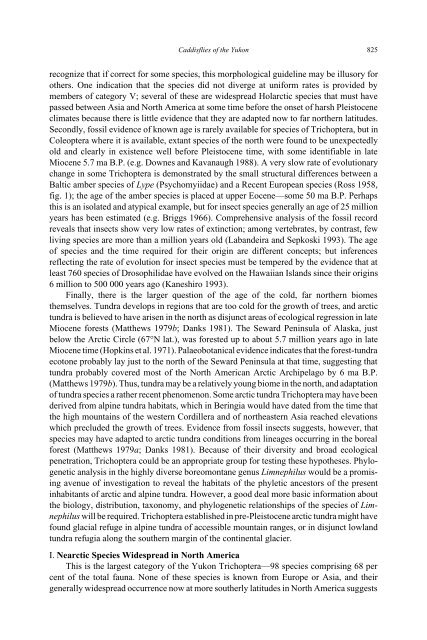Caddisflies of the Yukon - Department of Biological Sciences ...
Caddisflies of the Yukon - Department of Biological Sciences ...
Caddisflies of the Yukon - Department of Biological Sciences ...
You also want an ePaper? Increase the reach of your titles
YUMPU automatically turns print PDFs into web optimized ePapers that Google loves.
<strong>Caddisflies</strong> <strong>of</strong> <strong>the</strong> <strong>Yukon</strong> 825<br />
recognize that if correct for some species, this morphological guideline may be illusory for<br />
o<strong>the</strong>rs. One indication that <strong>the</strong> species did not diverge at uniform rates is provided by<br />
members <strong>of</strong> category V; several <strong>of</strong> <strong>the</strong>se are widespread Holarctic species that must have<br />
passed between Asia and North America at some time before <strong>the</strong> onset <strong>of</strong> harsh Pleistocene<br />
climates because <strong>the</strong>re is little evidence that <strong>the</strong>y are adapted now to far nor<strong>the</strong>rn latitudes.<br />
Secondly, fossil evidence <strong>of</strong> known age is rarely available for species <strong>of</strong> Trichoptera, but in<br />
Coleoptera where it is available, extant species <strong>of</strong> <strong>the</strong> north were found to be unexpectedly<br />
old and clearly in existence well before Pleistocene time, with some identifiable in late<br />
Miocene 5.7 ma B.P. (e.g. Downes and Kavanaugh 1988). A very slow rate <strong>of</strong> evolutionary<br />
change in some Trichoptera is demonstrated by <strong>the</strong> small structural differences between a<br />
Baltic amber species <strong>of</strong> Lype (Psychomyiidae) and a Recent European species (Ross 1958,<br />
fig. 1); <strong>the</strong> age <strong>of</strong> <strong>the</strong> amber species is placed at upper Eocene—some 50 ma B.P. Perhaps<br />
this is an isolated and atypical example, but for insect species generally an age <strong>of</strong> 25 million<br />
years has been estimated (e.g. Briggs 1966). Comprehensive analysis <strong>of</strong> <strong>the</strong> fossil record<br />
reveals that insects show very low rates <strong>of</strong> extinction; among vertebrates, by contrast, few<br />
living species are more than a million years old (Labandeira and Sepkoski 1993). The age<br />
<strong>of</strong> species and <strong>the</strong> time required for <strong>the</strong>ir origin are different concepts; but inferences<br />
reflecting <strong>the</strong> rate <strong>of</strong> evolution for insect species must be tempered by <strong>the</strong> evidence that at<br />
least 760 species <strong>of</strong> Drosophilidae have evolved on <strong>the</strong> Hawaiian Islands since <strong>the</strong>ir origins<br />
6 million to 500 000 years ago (Kaneshiro 1993).<br />
Finally, <strong>the</strong>re is <strong>the</strong> larger question <strong>of</strong> <strong>the</strong> age <strong>of</strong> <strong>the</strong> cold, far nor<strong>the</strong>rn biomes<br />
<strong>the</strong>mselves. Tundra develops in regions that are too cold for <strong>the</strong> growth <strong>of</strong> trees, and arctic<br />
tundra is believed to have arisen in <strong>the</strong> north as disjunct areas <strong>of</strong> ecological regression in late<br />
Miocene forests (Mat<strong>the</strong>ws 1979b; Danks 1981). The Seward Peninsula <strong>of</strong> Alaska, just<br />
below <strong>the</strong> Arctic Circle (67°N lat.), was forested up to about 5.7 million years ago in late<br />
Miocene time (Hopkins et al. 1971). Palaeobotanical evidence indicates that <strong>the</strong> forest-tundra<br />
ecotone probably lay just to <strong>the</strong> north <strong>of</strong> <strong>the</strong> Seward Peninsula at that time, suggesting that<br />
tundra probably covered most <strong>of</strong> <strong>the</strong> North American Arctic Archipelago by 6 ma B.P.<br />
(Mat<strong>the</strong>ws 1979b). Thus, tundra may be a relatively young biome in <strong>the</strong> north, and adaptation<br />
<strong>of</strong> tundra species a ra<strong>the</strong>r recent phenomenon. Some arctic tundra Trichoptera may have been<br />
derived from alpine tundra habitats, which in Beringia would have dated from <strong>the</strong> time that<br />
<strong>the</strong> high mountains <strong>of</strong> <strong>the</strong> western Cordillera and <strong>of</strong> nor<strong>the</strong>astern Asia reached elevations<br />
which precluded <strong>the</strong> growth <strong>of</strong> trees. Evidence from fossil insects suggests, however, that<br />
species may have adapted to arctic tundra conditions from lineages occurring in <strong>the</strong> boreal<br />
forest (Mat<strong>the</strong>ws 1979a; Danks 1981). Because <strong>of</strong> <strong>the</strong>ir diversity and broad ecological<br />
penetration, Trichoptera could be an appropriate group for testing <strong>the</strong>se hypo<strong>the</strong>ses. Phylogenetic<br />
analysis in <strong>the</strong> highly diverse boreomontane genus Limnephilus would be a promising<br />
avenue <strong>of</strong> investigation to reveal <strong>the</strong> habitats <strong>of</strong> <strong>the</strong> phyletic ancestors <strong>of</strong> <strong>the</strong> present<br />
inhabitants <strong>of</strong> arctic and alpine tundra. However, a good deal more basic information about<br />
<strong>the</strong> biology, distribution, taxonomy, and phylogenetic relationships <strong>of</strong> <strong>the</strong> species <strong>of</strong> Limnephilus<br />
will be required. Trichoptera established in pre-Pleistocene arctic tundra might have<br />
found glacial refuge in alpine tundra <strong>of</strong> accessible mountain ranges, or in disjunct lowland<br />
tundra refugia along <strong>the</strong> sou<strong>the</strong>rn margin <strong>of</strong> <strong>the</strong> continental glacier.<br />
I. Nearctic Species Widespread in North America<br />
This is <strong>the</strong> largest category <strong>of</strong> <strong>the</strong> <strong>Yukon</strong> Trichoptera—98 species comprising 68 per<br />
cent <strong>of</strong> <strong>the</strong> total fauna. None <strong>of</strong> <strong>the</strong>se species is known from Europe or Asia, and <strong>the</strong>ir<br />
generally widespread occurrence now at more sou<strong>the</strong>rly latitudes in North America suggests
















